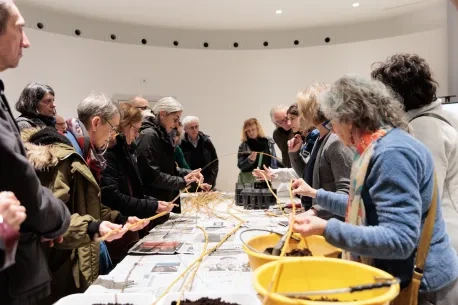Involving citizens for better air quality measures: the 5 UIA cities leading the way

The European Union, with a number of legislations under the Clean Air Policy Package for Europe , aimed to achieve air pollutants concentrations below the WHO guideline values across the continent.
In this panorama, a pivotal role is played by cities that by controlling a range of instruments (e.g. urban planning, infrastructure/traffic management, housing permits), allow to steer and promote innovative solutions aiming at mitigating air pollution. Moreover, as the closest level of government to citizens, cities are key to ensure the involvement of the residents in the development of air quality measures. However, the general public is still not engaging enough in air quality policy initiatives and the level of awareness and knowledge of the effects of poor air quality on our health is too low. The Urban Agenda Partnership on Air Quality "has found that differences in the level of awareness about the negative impacts of pollution on health, represent a barrier to the effectiveness of air quality policy measures" and that "increased public awareness about health benefits of clean air and active citizens involvement is therefore essential for improving social acceptance of and support for air quality management measures".
Citizens' roles and social acceptance for air quality practices is what the 5 cities - funded as part of the 3rd call for proposal of the Urban Innovative Actions programme – are going to address. Aix Marseille Provence (FR), Breda (NL), Helsinki (FI), Ostrava (CZ) and Portici (IT) are all proposing innovative air quality measures where the involvement of residents and the public play a crucial role.
As Air Quality will be one of the four thematic areas addressed also by the UIA fifth Call for Proposals opening in September 2019, this article will illustrate the innovative solutions that are already being implemented by the selected cities.
Starting from different challenges and standing points, the five projects include innovative elements of citizen’s science, communication and data visualization, citizen’s behaviour as well as new governance structures that enable a better coordination of the policy-making process.
The active involvement of citizens is clearly shown by the case of AirQon (Breda) , where the city aims to substitute diesel generators with an energy supply system based on Electric Vehicle (EV) batteries to provide off-grid energy for outdoor festivals and events. The solution is based on introducing an innovative technology (V2Box) to control bi-directional energy flow to and from EV batteries. This is supported by societal innovation: building up and managing a community of EV owners willing to fuel open-air events with clean electricity. Demand and supply will be matched through an online platform and mutually beneficial incentive schemes. The final ambition is to ensure that around 35% of all events will be utilizing V2Box technology for their off-grid energy demand preventing nearly 80,000 litres of diesel to be burnt in generators yearly in Breda.
A co-design and change of behaviour is the main purpose of HOPE (Helsinki): empower citizens to develop their own districts and help them plan their lives based on empirical data and science-based information concerning air quality. The project final ambition is to create a feedback loop between high resolution hyperlocal air quality data and actions of individuals and communities, co-design and participative budgeting. In-depth knowledge of the kind of exposure individuals from different backgrounds go through in their daily lives will be offered. A platform will gather all the data triggering new innovative solutions, while supporting a participatory budgeting model to involve users co-designing and co-developing, co-choosing AQ1 interventions.
In the DIAMS project (Aix Marseille Provence) tackling the Metropole’s air quality problems can only be solved by creating an alliance involving citizens, community leaders as well as private and public stakeholders. By building an open source data-exchange platform focused on service delivery, the project aims to achieve five strictly interrelated objectives. First it aims to improve air quality information and produce high quality, detailed and adaptive data by combining the power of IoT, citizens’ science and experienced local actors. It will also enable a fluid territorial air quality data exchange among urban, regional and national authorities to facilitate integrated planning. The wealth of data collected will be designed as a source of inspiration for citizens and private sector creativity to co-design innovative solutions tackling air pollution. Last but not least the project aims to provide adaptive and personalised information on air quality and related measures to citizens.
AIR-HERITAGE aims to improve the air quality conditions in Portici, by developing an integrated framework that brings together citizens, urban authorities and environmental protection agencies to design and implement science based air quality policies. Core of the project is the development of high resolution pollutant mapping capability. It will be built by fusing data produced by an air quality monitoring network integrating regulatory monitoring stations, fixed stations and citizens’ mobile personal exposure analysers. Data will be used to fuel a new Air Quality Policy Decision Support System. Through stakeholder involvement, groups will be trained with specific campaigns and ad-hoc tasking to cooperate as well as to monitor actions during their usual mobility pattern. Citizen engagement in air quality policies will be enhanced through availability of personal exposure, feedback and targeted data sharing creating a crowd sensing social network that will become part of the city’s policy making process.
With CLAIRO project , the city of Ostrava aims to gradually and systematically decrease air pollution, while contributing to generate new knowledge to improve the environment and to optimize health and quality of life among citizens. A living vegetation lab that facilitate the design of city greenery in the most efficient structure, together with an accurate measurement, robust data, new scientific solutions and involvement of experts from different sectors, will allow the testing of a new methodology which will provide positive impact on air quality. The solution will be shared throughout the high polluted Silesian industrial agglomeration as well as in other Czech and European cities.
You can find out more about what the projects are implementing by visiting their individual webpages here.
More information on the 5th call for proposals and the detail definition of the Air Quality subtopics will be available starting from April 2019. Stay tuned!
About this resource
The Urban Innovative Actions (UIA) is a European Union initiative that provided funding to urban areas across Europe to test new and unproven solutions to urban challenges. The initiative had a total ERDF budget of €372 million for 2014-2020.
Similar content




